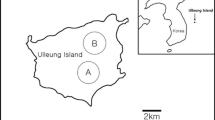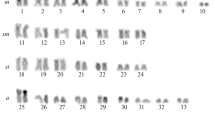Abstract
The aim of this work was to determine the cytogenetic characteristics of Brazilian Lippia alba (Mill) N. E. Brown and Lantana camara Plum. that could be useful for future characterization of these genera. Our analyses revealed that Li. alba has 2n=30 chromosomes consisting of ten metacentric and five submetacentric pairs, while La. camara has 44 metacentric chromosomes. The large blocks of heterochromatin seen in both species suggest an apomorphic condition. Six 45S rDNA sites were detected in both species by fluorescence in situ hybridization (FISH). Two and four 5S rDNA sites were observed in Li. alba and La. camara, respectively. Meiotic analysis revealed a normal chromosomal behaviour. The number of chromosomes and the presence of 45S rDNA and 5S rDNA sites do not exclude a possible polyploid origin. The cytogenetic differences between La. camara and Li. alba may be useful markers for differentiating these species.


Similar content being viewed by others
References
Andrada AB, Pastoriza A, Martínez-Pulido LV (1998) Citogenética en tres espécies de Verbenaceas. Rev Fac Agron 15:312–318
Bose RB, Choudhury JK (1960) Cytological studies in L. alba (Mill) N. E. Br. Bot Bull Soc Bengal 14:71–72
Brandão AD, Viccini LF, Pezzin R (2000) Meiotic characterization in Lippia alba (Verbenaceae). Genet Mol Biol 23 [Suppl]:372–372
Carvalho CR (1995) Desenvolvimento de tecnologia citogenética em milho (Zea mays L.). Dissertation, PhD thesis, Universidade Federal de Viçosa, Brazil
Choudhary SS, Roy RP (1983) Karyological studies and trend of speciation in some members of Verbenaceae. Cytologia 48:735–740
Coleman JR (1982) Chromosome numbers of angiosperms collected in the state of São Paulo. Rev Bras Genet 3:533–549
Corazza-Nunes MJ, Pagliarini MS, Silva N, Silva I (1995) Hexaploidy and fertility interrelationships in Aloysia lycioides (Verbenaceae). Arq Biol Tecnol 38:627–630
Dagne K (2001) Cytogenetics of new Guizotia Cass. (Compositae) interspecific hybrids pertaining to genomic and phylogenetic affinities. Plant Syst Evol 230:1–11
Edelman JR, Lin YJ (1995) Repetitive DNA/heterochromatin: can it be the “driving force” of evolution and speciation? Cytobios 83:117–127
Filippa EM (1984) El numero cromossomico de L. turbinata (Verbenáceae). Kurtziana 17:169–170
Gerlach WL, Bedbrook JR (1979) Cloning and characterization of ribosomal RNA genes from wheat and barley. Nucleic Acids Res 7:1869–1885
Gerlach WL, Dyer TA (1980) Sequence organization of the repeating units in the nucleus of wheat which contains 5S-rRNA genes. Nucleic Acids Res 8:4851–4865
Greilhuber J (1979) C-band distribution, DNA content, and basic composition in Ardoxa maschatellina (Ardoxaceae), a plant with cold sensitive chromosome segments. Plant Syst Evol 129:63–109
Grif VG (2000) Some aspects of plant karyology and karyosystematics. Int Rev Cytol 196:131–175
Hanson RE, Islam-Faridi MN, Percival EA, Crane CF, Ji Y, McKnight TD, Stelly DM, Price HJ (1996) Distribution of 5S and 18S-26S rDNA loci in a tetraploid cotton (Gorssypinum hirsutum L.) and its putative diploid ancestors. Chromosoma 105:55–61
Heslop-Harrison JS, Schwarzacher K, Anamthawat-Jonsson AR, Leitch M, Leitch IJ (1991) In situ hybridization with automated chromosome denaturation. Technique 3:106–109
Judd WS, Campbell CS, Kellogg EA, Stevens PF (1999) Plant systematics: a phylogenetic approach. Sinauer Assoc, Sunderland
Kumar P, Dutt B (1989) Cytogenetic basis of breeding system in some verbenaceous species. Cytologia 54:347–353
Mesa JTRY (1945) Plantas medicinales: aromaticas o venenosas de Cuba. Editorial Guerrero, Havana
Moldenke HNA (1965) Materials toward a monograph of the genus Lippia I. Phytologia 12:6–71
Redi CA, Garagna S, Zacharias H, Zuccotti M, Capanna E (2001) The other chromatin. Chromosoma 110:136–147
Salimena FRG (2002) New synonyms and typifications in Lippia sect. Rhodolippia (Verbenaceae). Darwiniana 40:121-125
Sanders RW (1987) Taxonomic significance of chromosome observations in Caribbean species of Lantana (Verbenaceae). Am J Bot 74:914–920
Sanders RW (2001) The genera of Verbenaceae in the southeastern United States. Harv Pap Bot 5:303–358
Schwarzacher T, Ambros P, Schweizer D (1980) Application of Giemsa banding to orchid karyotype analyses. Plant Syst Evol 134:293–297
Sen NK, Sahni VM (1955) Triploid, tetraploid and pentaploid Lantana camara. Sci Cult 20:558–559
Silva TRS (1999) Redelimitação e revisão taxonômica do gênero Lantana L. (Verbenaceae) no Brasil. Dissertation, PhD thesis, Universidade Federal de São Paulo, Brazil
Singh B (1951) Chromosome numbers in some flowering plants. Curr Sci 20:105
Sinha S, Sharma A (1984) Lantana camara L. A review. Feddes Repert 95:621–633
Spies JJ (1984) A cytotaxonomic study of Lantana camara (Verbenaceae) from South Africa. S Afr J Bot 3:231–250
Stace CA (2000) Cytology and cytogenetics as a fundamental taxonomic resource for the 20th and 21st centuries. Taxon 49:451–477
Tandon SL, Chandi AS (1955) Basic chromosome number of Lantana camara L. Curr Sci 4:124–125
Acknowledgements
The authors thank R. Pezzin, M.R. Pereira, P.M.O. Pierre, E.A.C. Romanel, J.S. Campos and A.L.C. Lima for collecting the specimens of Li. alba and La. camara, Dr. V.N. Solferini for permission to use the greenhouse and Dr. E.R.F. Martins for valuable discussions. This work was supported by FAPESP (grant. no. 00/11842-2; a scholarship to A. D. Brandão), FAPEMIG (grant no. CBB 2728/98) and FINEP (grant no. 0930/01).
Author information
Authors and Affiliations
Corresponding author
Rights and permissions
About this article
Cite this article
Brandão, A.D., Viccini, L.F., Salimena, F.R.G. et al. Cytogenetic characterization of Lippia alba and Lantana camara (Verbenaceae) from Brazil. J Plant Res 120, 317–321 (2007). https://doi.org/10.1007/s10265-006-0041-4
Received:
Accepted:
Published:
Issue Date:
DOI: https://doi.org/10.1007/s10265-006-0041-4




